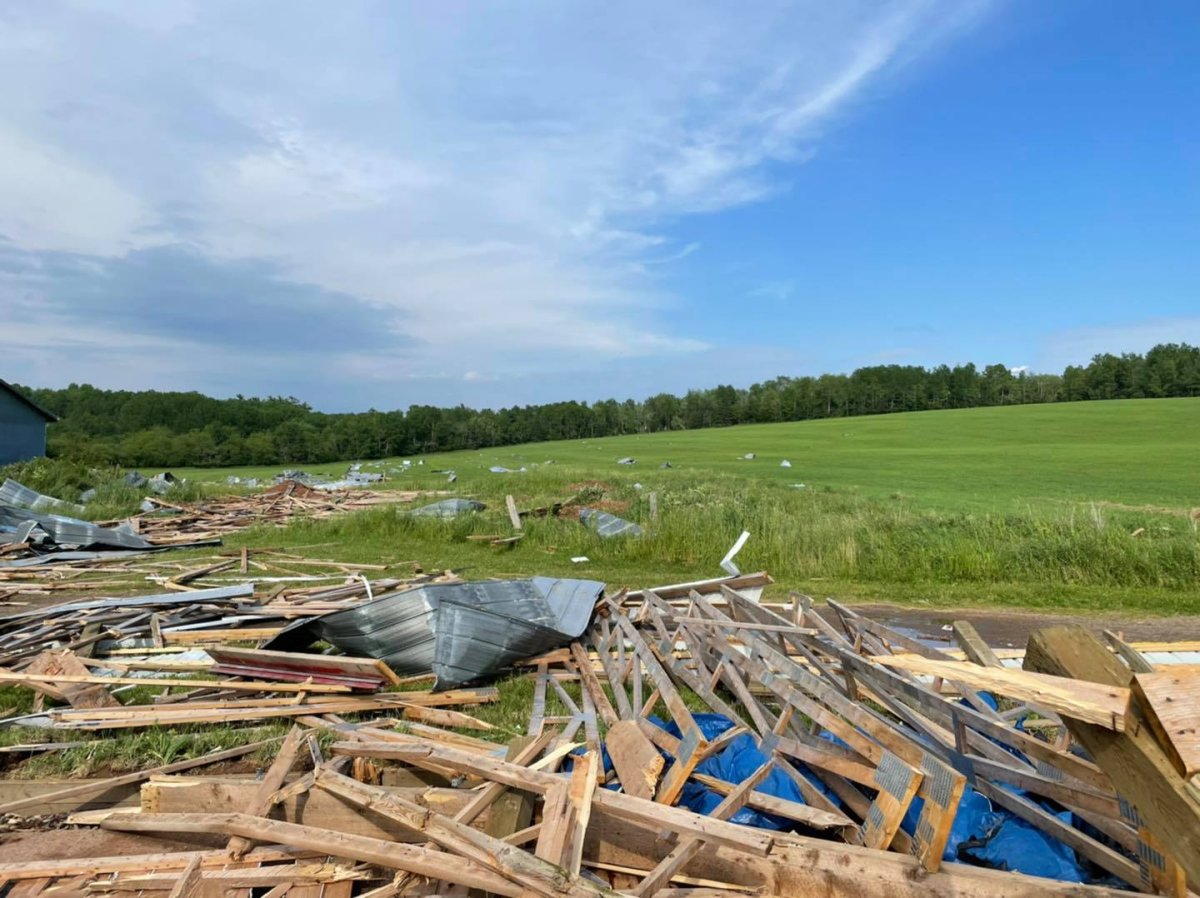Environment Canada is investigating whether a tornado was responsible for the damage caused during an intense storm that uprooted trees and demolished a barn in Stewiacke, N.S., over the last week.

On Wednesday, the storm made its way through the area around 3 p.m., bringing with it heavy rain, hail, and wind gusts up to 90 km/h. Later that evening, an intense system hit part of New Brunswick, where it peeled part of the roof off a local school.
Ian Hubbard, a meteorologist with Environment and Climate Change Canada, said the weather agency is investigating whether a tornado had indeed touched down in Stewiacke.
“It’s not a cut-and-dry situation, to either say, ‘Yes, it was a tornado,’ or ‘No, it wasn’t,’” said Hubbard. “There’s certainly some evidence there that we’re still looking at.”
Hubbard said some people reported seeing clouds rotating, which could be an indicator of a tornado, but the strong winds and torrential rain would have made it difficult for people to see clearly.
“You would have to be in a very particular spot in relation to the storm to even have a chance at seeing a tornado, so it’s very difficult to confirm them visually, certainly in our part of the world, anyway,” he said.
“We certainly didn’t see any direct evidence – yet, anyway, maybe somebody has something that might come in – certainly no visual evidence of a tornado spotted or recorded.”
Without the visual evidence of a tornado, Hubbard said Environment Canada is mainly relying on the damage caused by the storm to figure out if it was indeed a tornado.
“It certainly can’t be ruled out based on the intensity of the storm and the damage we witnessed happening,” he said.
According to Hubbard, the storm began in New Brunswick – where it knocked out power for thousands of people after lightning struck an NB Power substation — and moved across the Bay of Fundy before landing in Nova Scotia.
“As it reached the land again in Nova Scotia, it was very hot, a lot of heat, a lot of energy built up, it really helped that storm just really take off and intensify as it moved across the land,” he said.
Hubbard said on the weather radar, the storm appeared as a “bow echo,” a band of rain or a cluster of thunderstorms shaped like an archer’s bow. Bow echoes can bring about severe straight-line winds and sometimes tornadoes.
New Brunswick storm
Hubbard noted that tornadoes are a “very rare” occurrence in Nova Scotia and are more common in neighbouring New Brunswick, which can see a tornado once every two years or so.
“For the most part, they’re a much different climate than us when they get their severe weather, because they’re not surrounded by water like we are,” he said.
“The water tends to cool the air around it, so (tornadoes) don’t have as long a period over hot and warm land to initiate their development.”
Late Wednesday evening, a thunderstorm hit New Brunswick, ripping part of the roof off of Carleton North High School in Florenceville-Bristol.
In that case, said Hubbard, they believe that damage was caused by what’s known as a “microburst.”
“In a thunderstorm, you have a large column of air that rushes down to the ground from higher up in the storm, and when that happens that air runs down to the ground, then it hits the ground and has nowhere to go, and it shoots outward horizontally along the ground,” he explained.
“They’ve been known to do a lot of damage over the years, and a lot of people, when they see this kind of damage, they think it had to have been something very serious like a tornado, but certainly the strength of the winds are just as damaging to buildings and structures and trees.”
Nobody was injured in either of the storms.










Comments